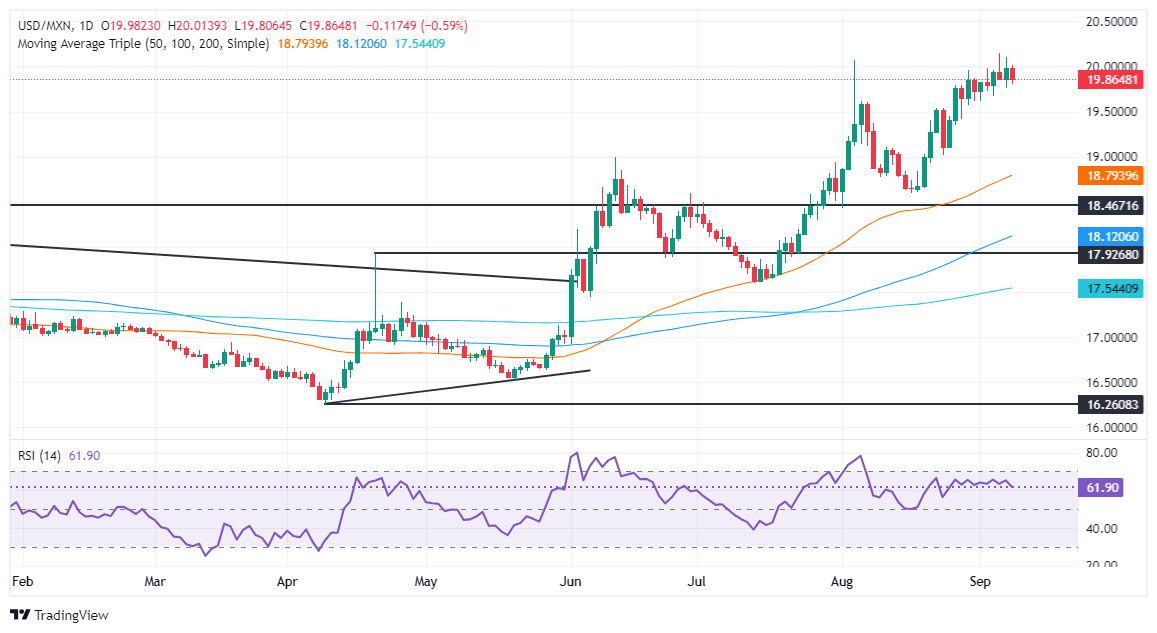Mexican Peso erases losses as inflation cools amid political uncertainty

- Mexican Peso strengthens as fears of judiciary reform approval fade despite Banxico's dovish stance.
- Opposition from 43 senators reduces chances of judiciary reform approval, easing political concerns in Mexico.
- Banxico’s dovish stance justified by declining inflation, while Business Confidence slightly improves but remains below 50.
The Mexican Peso staged a comeback against the Greenback on Monday. Fears that the judiciary reform would be approved faded after 43 opposition senators reiterated their vote against it. The USD/MXN trades at 19.86, down by 0.42%.
The USD/MXN pair continues to be driven by political issues. However, the latest inflation report justified the Bank of Mexico's (Banxico) dovish stance as headline and core figures dipped on an annual reading.
Other data showed that Business Confidence improved slightly but remained below the 50 threshold.
In the meantime, Julius Baer warned that rating agencies could change Mexico’s creditworthiness as soon as next year if the judicial reform is approved. Erini Tsekeridou, a fixed-income analyst, said, “Although the economic impact is not yet fully clear, markets are concerned about the potential weakening of the rule of law and the concentration of judicial and executive power, which would reduce oversight and accountability.”
Julius Baer added their name to Morgan Stanley, Bank of America, JP Morgan, Citibanamex and Fitch ratings warnings of the economic and financial impact regarding the approval of judicial reform.
Across the border, the US economic docket revealed the New York Fed’s consumer inflation expectations, which remained unchanged at 3%. However, market players are still eyeing Wednesday's release of August’s Consumer Price Index (CPI).
Daily digest market movers: Mexican Peso recovers ground on judicial reform expected vote
- Mexico’s Inflation in August rose by 4.99% YoY, below estimates of 5.09% and the previous reading of 5.57%. Core Inflation dipped a tenth to 4% YoY.
- Traders expect Banxico to cut interest rates at the upcoming September 26 monetary policy decision.
- Mexico’s economic docket remains light. On Wednesday, September 11, the Senate approved the judiciary reform. Earlier, INEGI will reveal Industrial Production figures.
- September’s Citibanamex Survey showed that Banxico is expected to lower rates to 10.25% in 2024 and to 8.25% in 2025. The USD/MXN exchange rate is forecast to end 2024 at 19.50 and 2025 at 19.85.
- US CPI is expected to dip from 2.9% to 2.6% YoY in August, while core CPI is projected to remain at 3.2%.
- Data from the Chicago Board of Trade (CBOT) suggests the Fed will cut at least 104.5 basis points this year, according to the fed funds rate futures contract for December 2024.
USD/MXN technical outlook: Mexican Peso appreciates as USD/MXN slides below 20.00
The USD/MXN uptrend remains intact despite the ongoing pullback on relief that judicial reform could not be approved. However, this will not be known until September 11.
Momentum shows signs of exhaustion, yet buyers remain in charge even though the Relative Strength Index (RSI) is slightly lower.
If the USD/MXN clears 20.00, the next ceiling level would be the YTD high at 20.22. On further strength, the pair could challenge the daily high of September 28, 2022, at 20.57. If those two levels are surrendered, the next stop would be the swing high at 20.82 on August 2, 2022, ahead of 21.00.
Conversely, if USD/MXN weakens further, the first support would be 19.50. A breach of the latter will expose the August 23 swing low of 19.02 before giving way for sellers eyeing a test of the 50-day Simple Moving Average (SMA) at 18.65.

Banxico FAQs
The Bank of Mexico, also known as Banxico, is the country’s central bank. Its mission is to preserve the value of Mexico’s currency, the Mexican Peso (MXN), and to set the monetary policy. To this end, its main objective is to maintain low and stable inflation within target levels – at or close to its target of 3%, the midpoint in a tolerance band of between 2% and 4%.
The main tool of the Banxico to guide monetary policy is by setting interest rates. When inflation is above target, the bank will attempt to tame it by raising rates, making it more expensive for households and businesses to borrow money and thus cooling the economy. Higher interest rates are generally positive for the Mexican Peso (MXN) as they lead to higher yields, making the country a more attractive place for investors. On the contrary, lower interest rates tend to weaken MXN. The rate differential with the USD, or how the Banxico is expected to set interest rates compared with the US Federal Reserve (Fed), is a key factor.
Banxico meets eight times a year, and its monetary policy is greatly influenced by decisions of the US Federal Reserve (Fed). Therefore, the central bank’s decision-making committee usually gathers a week after the Fed. In doing so, Banxico reacts and sometimes anticipates monetary policy measures set by the Federal Reserve. For example, after the Covid-19 pandemic, before the Fed raised rates, Banxico did it first in an attempt to diminish the chances of a substantial depreciation of the Mexican Peso (MXN) and to prevent capital outflows that could destabilize the country.





.jpg)
